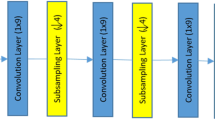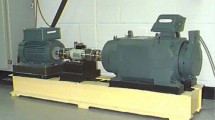Abstract
The success of convolutional neural networks (CNNs) in intelligent fault diagnosis is largely dependent on massive amounts of labelled data. In a real-world case, however, massive amounts of labelled data are difficult or costly to collect, whereas abundant unlabelled data are often available. To utilize such unlabelled data, a novel method using a semi-supervised convolutional neural network (SSCNN) for intelligent fault diagnosis of bearings is proposed. First, a 1-d CNN is applied to learn class space features and generate class probabilities of unlabelled samples, based on which a class probability maximum margin criterion (CPMMC) method is used to construct the loss function of unlabelled samples. Then, the constructed loss function, which aims to maximise the inter-class distance of class space features and minimise the intra-class distance of class space features, is integrated into the cross-entropy loss function of the CNN, and the SSCNN is established. Finally, the SSCNN model is applied to analyse the vibration signals collected from rolling bearings, and a novel intelligent fault diagnosis method using the SSCNN is proposed. Two datasets are employed to validate the effectiveness of the proposed methodology. The results show that the established SSCNN can effectively utilise unlabelled samples to train the model and enhance its fault diagnosis performance. Through a comparison with commonly used semi-supervised deep learning methods, the superiority of the proposed method is validated.












Similar content being viewed by others
Explore related subjects
Discover the latest articles, news and stories from top researchers in related subjects.References
Shao H, Jiang H, Lin Y, Li X (2018) A novel method for intelligent fault diagnosis of rolling bearings using ensemble deep auto-encoders. Mech Syst Signal Process 102:278–297
Guo X, Chen L, Shen C (2016) Hierarchical adaptive deep convolution neural network and its application to bearing fault diagnosis. Measurement 93:490–502
Wu Z, Jiang H, Zhao K, Li X (2020) An adaptive deep transfer learning method for bearing fault diagnosis. Measurement 151:107227
Rashid MM, Amar M, Gondal I, Kamruzzaman J (2016) A data mining approach for machine fault diagnosis based on associated frequency patterns. Appl Intell 45:638–651
Liu R, Yang B, Zio E, Chen X (2018) Artificial intelligence for fault diagnosis of rotating machinery: a review. Mech Syst Signal Process 108:33–47
Zhao X, Jia M (2019) A novel unsupervised deep learning network for intelligent fault diagnosis of rotating machinery, Structural Health Monitoring, 1–19
Jia F, Lei Y, Lin J, Zhou X, Lu N (2016) Deep neural networks: a promising tool for fault characteristic mining and intelligent diagnosis of rotating machinery with massive data. Mech Syst Signal Process 72-73:303–315
Chen Z, Li W (2017) Multisensor feature fusion for bearing fault diagnosis using sparse autoencoder and deep belief network. IEEE Trans Instrum Meas 66:1693–1702
Zhao M, Kang M, Tang B, Pecht M (2018) Deep residual networks with dynamically weighted wavelet coefficients for fault diagnosis of planetary gearboxes. IEEE Trans Ind Electron 65:4290–4300
Zhou F, Yang S, Fujita H, Chen D, Wen C (2020) Deep learning fault diagnosis method based on global optimization GAN for unbalanced data. Knowl-Based Syst 187:104837
Janssens O, Slavkovikj V, Vervisch B, Stockman K, Loccufier M, Verstockt S, Van de WR, Van HS (2016) Convolutional neural network based fault detection for rotating machinery. J Sound Vibr 377:331–345
Wang F, Jiang H, Shao H, Duan W, Wu S (2017) An adaptive deep convolutional neural network for rolling bearing fault diagnosis. Meas Sci Technol 28:095005
Jing L, Zhao M, Li P, Xu X (2017) A convolutional neural network based feature learning and fault diagnosis method for the condition monitoring of gearbox. Measurement 111:1–10
Wen L, Li X, Gao L, Zhang Y (2018) A new convolutional neural network based data-driven fault diagnosis method. IEEE Trans Ind Electron 65:5990–5998
Zhang W, Peng G, Li C, Chen Y, Zhang Z (2017) A new deep learning model for fault diagnosis with good anti-noise and domain adaptation ability on raw vibration signals. Sensors 17:425
Zhang W, Li C, Peng G, Chen Y, Zhang Z (2018) A deep convolutional neural network with new training methods for bearing fault diagnosis under noisy environment and different working load. Mech Syst Signal Process 100:439–453
Zhou Z, Li M (2010) Semi-supervised learning by disagreement. Knowl Inf Syst 24:415–439
Van E, Jesper E, Holger H (2020) A survey on semi-supervised learning. Mach Learn 109:373–440
Laine S, Aila T (2016) Temporal ensembling for semi-supervised learning, 2016 international conference on learning representations
Rasmus A, Valpola H, Honkala M, Berglund M, Raiko T (2015) Semi-supervised learning with ladder networks, 2015 29th Annual Conference on Neural Information Processing Systems, 28
Yue Z, Gao F, Xiong Q, Wang J, Huang T, Yang E, Zhou H (2019) A novel semi-supervised convolutional neural network method for synthetic aperture radar image recognition. Cogn Comput 3:1–19
Gu J, Wang Z, Kuen J, Ma L, Shahroudy A, Shuai B, Liu T, Wang X, Wang G, Cai J, Chen T (2018) Recent advances in convolutional neural networks. Pattern Recogn 77:354–377
LeCun Y, Bengio Y, Hinton G (2015) Deep learning. Nature 521:436–444
Cui Y, Fan L (2012) Feature extraction using fuzzy maximum margin criterion. Neurocomputing 86:52–58
Lu G, Lin Z, Jin Z (2010) Face recognition using discriminant locality preserving projections based on maximum margin criterion. Pattern Recogn 43:3572–3579
Bergstra J, Bengio Y (2012) Random search for hyperparameter optimization. J Mach Learn Res 13:281–235
Zhang L, Suganthan PN (2016) A survey of randomized algorithms for training neural networks. Inf Sci 364-365:146–155
Szegedy C, Vanhoucke V, Ioffe S, Shlens J, Wojna Z (2016) Rethinking the inception architecture for computer vision, 2016 IEEE conference on computer vision and. Pattern Recogn:2818–2826
Abdel-Hamid O, Li D, Dong Y (2013) Exploring convolutional neural network structures and optimization techniques for speech recognition, 2013 14th Annual Conference of the International-Speech-Communication-Association, 3365–3369
Kingma D P, Jimmy B (2014) Adam: A method for stochastic optimization, Computer Science
Case Western Reserve University Bearing Data Center Website Available at: http://csegroups.case.edu/bearingdata center/ home
van der ML, Hinton G (2008) Visualizing data using t-SNE. J Mach Learn Res 9:2579–2605
Acknowledgements
This work is supported by the National Natural Science Foundation of China (No. 51675253) and China Postdoctoral Science Foundation (No. 2016 M592857).
Author information
Authors and Affiliations
Corresponding author
Additional information
Publisher’s note
Springer Nature remains neutral with regard to jurisdictional claims in published maps and institutional affiliations.
Rights and permissions
About this article
Cite this article
Wu, Y., Zhao, R., Jin, W. et al. Intelligent fault diagnosis of rolling bearings using a semi-supervised convolutional neural network. Appl Intell 51, 2144–2160 (2021). https://doi.org/10.1007/s10489-020-02006-6
Accepted:
Published:
Issue Date:
DOI: https://doi.org/10.1007/s10489-020-02006-6




